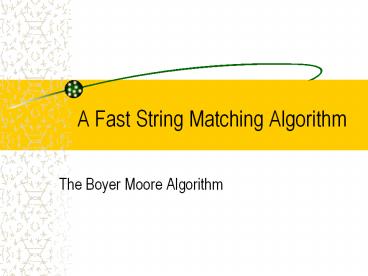A Fast String Matching Algorithm - PowerPoint PPT Presentation
1 / 18
Title:
A Fast String Matching Algorithm
Description:
Knuth-Pratt-Morris Algoritm Linear search algorithm. Preprocesses pat in time linear in and searches str in time linear in . EXAMPLE HERE IS A SIMPLE ... – PowerPoint PPT presentation
Number of Views:132
Avg rating:3.0/5.0
Title: A Fast String Matching Algorithm
1
A Fast String Matching Algorithm
- The Boyer Moore Algorithm
2
The obvious search algorithm
- Considers each character position of str and
determines whether the successive patlen
characters of str matches pat. - In worst case, the number of comparisons is in
the order of . - Ex. pat aab str ..aaaaac .
3
Knuth-Pratt-Morris Algoritm
- Linear search algorithm.
- Preprocesses pat in time linear in
and searches str in time linear in
. - EXAMPLE
- HERE IS A SIMPLE EXAMPLE
EXAMPLE
EXAMPLE
EXAMPLE
4
Characteristics of Boyer Moore Algorithm
- Basic idea string matches the pattern from the
right rather than from the left. - Preprocessing pat and compute two tables
- for shifting pat
the pointer of str. - Ex. pat AT-THAT str WHICH-FINALLY-HALTS
.AT-THAT-POINT
5
Informal Description
- Compare the last char of the pat with the
patlenth char of str - AT-THAT
- WHICH-FINALLY-HALTS.AT-THAT-POINT
- Observation 1 char is not to occur in pat, skip
- chars of str.
AT-THAT
6
Informal Description
- Observation 2 char is in pat, slide pat down
- positions so that char is aligned to the
corresponding character in pat. - if char not occur in
pat,then else - , where j is the maximum
integer such that - .
AT-THAT WHICH-FINALLY-HALTS.--AT-THAT-P
OINT
7
Informal Description
- Observation 3a str matches the last m chars of
pat, and came to a mismatch at some new char.
Move strptr by .(pat shifted by
) - AT-THAT
- FINALLY-HALTS.--AT-THAT-POINT
AT-THAT
8
Informal Description
- Observation 3b the final m chars of pat (a
subpat) is matched, find the right most plausible
reoccurrence of the subpat, align it with the
matched m chars of str (slide pat
positions). - AT-THAT
- FINALLY-HALTS.AT-THAT-POINT
AT-THAT
AT-THAT
9
The delta1 delta2 tables
- The delta1 table has as many entries as there are
chars in the alphabet. - Ex. pat a b c d e a t t h a t
- 4 3 2 1 0 else,5 1 0 4 0 2 1 0
else,7 - The delta2 table has as many entries as there are
chars in pat. - Ex. pat a b c d e a t - t h a t
- 9 8 7 6 1 11 10 9 8 7 8 1
10
- Ex we compute j5
- j 1 2 3 4 5 6 7
- Pat e d b c a b c
- e d b c a b c
- -2 -1 0 1 2 3 4 5 6 7
- Then
11
The algorithm
- stringlen length of string.
- i patlen.
- top if i gt stringlen then return false.
- j patlen.
- loop if j0 then return i1.
- if string(i)pat(j)
- then
- j j-1
- i i-1
- goto loop.
- close
- i i max( delta1(sting(i)) , delta2(j))
- goto top.
12
Implementation Consideration
13
Loops fast, undo, slow
- Fastscans down string, effectively looking for
the last character in pat,
skipping according to . - 80 time spent in it.
- Undodecides whether this situation arose because
all of string has been scanned or because
was hit. - Slowbacks up checking for matches.
- It is easy to implement on a byte addressable
machine - Char lt- string (i), etc
14
Measured the cost of each search
- Three stringsbinary alphabet, English, random
alphabet. - Fig.1the number of references made to string.
- Fig.2the total number of machine instruction
that actually got executed.
15
Performance (empirical evidence)
16
Boyer Moore V.S. Knuth, Morris, and Pratt
algorithm
- for English text.
- Boyer Moore
- every reference to string passes about 4
characters for a pattern of length 5. - For sufficiently large alphabets and sufficiently
long patterns executes fewer than 1 instruction
per character passed. - K.M.P.
- Search reference string about 1.1 times per
character. - a character can be expected to be at least 3.3
instructions.
17
Conclusion
- Require fewer CPU cycle.
- Most efficiently on a byte-addressable machine.
- Unadvisableto find the first of several possible
substrings or to identify a location in string
defined by a regular expression. - Aho and Corasick is more suitable.
18
Conclusion
- Improveby fetching larger bytes in the fast loop
and using a hash array to encode the extended
. - Exponentially increases the effective size of the
alphabet and reduces the frequency of common
characters.































